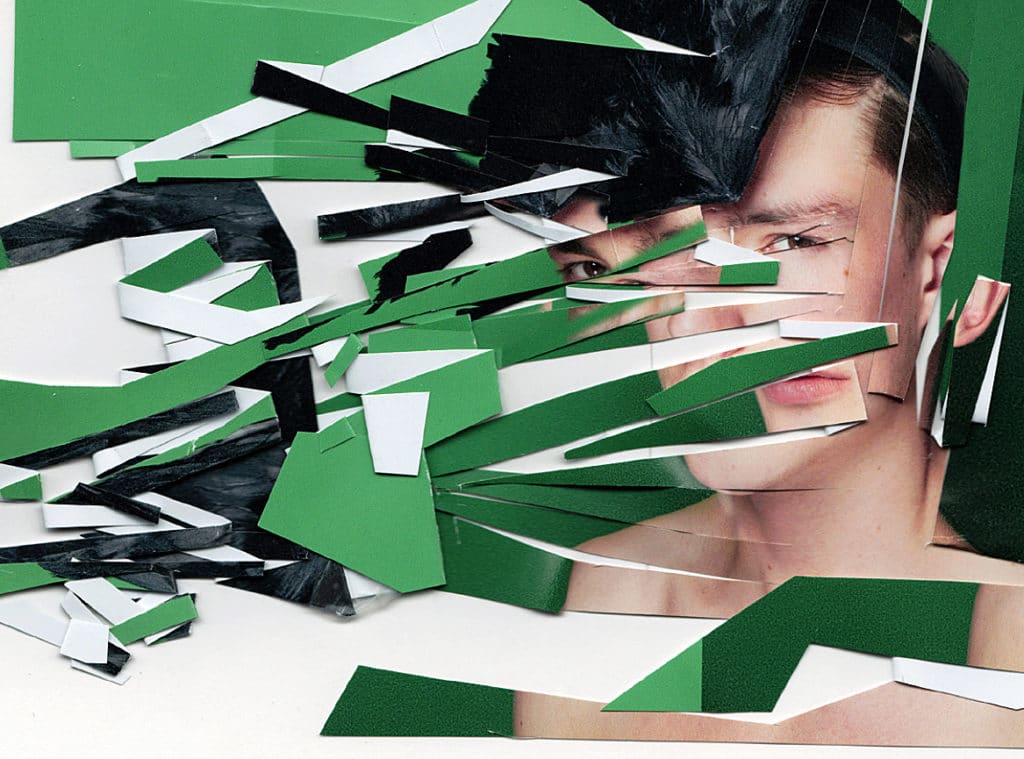
The closest way I could describe my artistic approach is Running With Scissors. I hold a masters degree in Architecture from Moscow Architectural University (МАРХИ), where scissors and all cutting tools became my “closest friends forever.” What interests me the most are human emotions and memory; what I enjoy the most is the array of images around us; what I use the most are scissors and knives. I cut and distort slides, photographs, film — mine or found images in order to get to the core of the image’s truth, a poetic truth (the only truth that exists). My desire for the image runs in the same direction as Roland Barthes’: ” … to explore photography not as a question (a theme) but as a wound”.
Like in Paper Surgery, where by crumbling faces from glossy magazines in a rather violent, Francis Bacon-like manner the images become monstrous yet strangely even more human than the originals. In the video projections from Into the Darkness Series, slide film materials are scanned mechanically overlapping each other until the image is almost gone. Figurative elements are slowly squeezed out of each still and eventually turned into a dark abstraction, similar to our memory bank. By disturbing and manipulating photographic material physically its collective memory is stirred up and a new meaning like a genie from a bottle is discovered and set free for myself and the viewer. “A photograph is always invisible, it is not it that we see… The photographic image is a message without a code.” *
Hidden spaces, gaps, voids in the connection or disconnection with what is visible — within the image itself and in relation to the way our memory works: with its fragmentation and thresholds between forgotten and brought back to life yet disfigured — is a territory of my artistic endeavour, with its constantly shifting landscape where violence & beauty, guilt & longing, pain & pleasure, distraction & forgiveness are bound to intertwine with each other.
* Roland Barthes “Camera Lucida”
BIO
Veronika Georgieva was born and raised in Moscow/Russia and currently based in New York City. She holds master degree in Architecture from Moscow Architectural University (MARKHI). Her video installations & photographic works explore connection between present and absent, between what is visible and what hidden. By manipulating photographic material physically she reveals a new, often disturbing meaning within the Image itself and/or in relation to the way our memory works: with its’ fragmentation & thresholds between forgotten & brought back to life yet disfigured. Georgieva’s Paper Surgery Series is successfully exposed worldwide due to the collaboration with fashion label Comme des Garçons for their advertising campaign spring/summer 2010. As well as collaboration with Saatchi & Saatchi advertising agency for 25-anniversary campaign for Reporters Without Borders, which got short listed for Cannes Golden Lion. The artist exhibited throughout the world in numerous exhibitions, included Drawing Center/New York, MoMA/New York, Ljubljana Contemporary Art Museum, Exploratorium Museum of Art and Science/San-Francisco, Gogol Museum/Moscow, Berlin State Museum / Germany , Moscow Biennale, parallel program to 14th Venice Architectural Biennale, Arnhem Mode Biennale. Georgieva’s works is included in museum & private collections in North America, Europe, Australia & Russia.
CV
lives & works in New York City & Moscow /
holds master degree in Architecture from Moscow Architectural University ( МАРХИ)
Commissions & Awards
2018 Alanica Project/Vladikavkaz awarded Koryokhin Prize/Saint Petersburg in nomination “Festival of the Year”
Alanica Project/Vladikavkaz nominated for prestigious Russian Prize “Innovation”
2014 Wallpaper Magazine Limited Edition Cover & “Final Cut” inside Project
2013 Senhoa Foundation, campaign against human trafficking / curated Julie Ragolia
2012 shortlisted for Lexus Hybrid Art Grant *
2011 Petrou\Man advertising campaign
2010 shortlisted for Cannes Golden Lions for Reporters Without Borders advertising campaign*
2010 Saatchi & Saatchi for Reporters Without Borders 25th anniversary advertising campaign*
2010 Comme des Garçons world-wide advertising campaign Spring-Summer 2010*
Exhibitions & Talks
2022 Upcoming Mirror Mirror. On Fashion & the Psyche / MoMu Fashion Museum, Antwerpen
2021 Recyclage des Formes / Espace Voltaire, Paris, curated Elizaveta Shagina & Marina Smorodinova
Portrait of an Artist / project for a movie “Jet Lag”, directed by Lily & Michael Idov
2020 Walking on snow wasn’t built in a day / Art x Puzzles: Puzzle with Purpose, New York, curated Rachel Vancelette
Monday — Every Day / project for 33 Moscow International Book Fair, collaboration with Toni Suits & Christina Steinbrecher–Pfandt
1X1 / Solyanka Gallery, Moscow, Russia
Artist’s Poetry / on-line project, Solyanka Gallery, Moscow, Russia
2019 Overlap, High Line Xposed, New York, NY ( two-person show)
Room with the View | “Zvezda” Cinema, in collaboration with Solyanka Gallery,
Moscow Ensemble of Contemporary Music (МАСМ) & MosKino ( solo show)
The Art of Perfection| Winzavod Contemporary Art Center in collaboration with
Москвич Mag & Dunlop company | Moscow | curated Marina Fedorovskaya
Co-Author | Oktava Multimedia Museum | Tula, Russia
2018 Memory Bank / project for FALL Magazine / London
Co-Author / State Contemporary Art Center / Vladikavkaz , Russia
Watermill Auction, The 25th Annual Watermill Center Summer Benefit, Water Mill, NY
Zin FEST / Ground Center / Moscow, Russia
Vladey Kavkazom / State Center of Contemporary Art / Moscow, Russia
Persona / project for TEGIN Fashion House / Moscow, Russia
2017 Watermill Auction, The 24th Annual Watermill Center Summer Benefit, Water Mill, NY/ curated Daneyal Mahmood
site-specific video installation for Alanica Festival, Vladikavkaz Contemporary Art Center, Russia / curated Katya Bochavar
Artist Talk with Christina Steinbrecher-Pfandt, director of Viennacontemporary ArtFair / parallel program Armory Show
Sanctuary / parallel program to the Armory Show / New York / curated Sebastiaan Bremer
Apartment 38 inaugural group exhibition / New York / curated Austin Thomas
Venture Dialogues / ATM Altamira Gallery / solo – project section JustMAD8 /
Madrid, Spain/ curated Tim Goossens
Dream Cinema, Ground Khodynka / Contemporary Art Center/ Moscow / curated Katya Bochavar
2016 Art After Hours, Zimmerli Art Museum / Rutgers, USA / curated Julia Tulovsky
In Politics We Trust / BOFFO poster show, Gavin Brown Enterprise, New York
In Politics We Trust / BOFFO poster show, Storefront for Art and Architecture, New York
SPIN2, Exploratorium Museum of Art and Science, San-Francisco USA *
Co-Author, Museum New Wing of Gogol, Moscow, Russia /curated Katya Bochavar *
Co-Author, Perm Art Center, Perm, Russia /curated Katya Bochavar *
2015 Memory Lane, project for AURORA FESTIVAL, Dallas, Texas USA / curated Tim Goossens
2014 SPIN, Exploratorium Museum of Art and Science, San-Francisco *
Project Moskva: Urban Space, parallel program, Ca’Rezzonico, 14th Venice
Architectural Biennale, Venice, Italy / curated Christina Steinbrecher-Pfandt
2012 Memory Confetti, Brooklyn Fine Arts, NY USA / curated Birte Kleeman*
Capricious Auction, Martos Gallery, NY USA*
Editions, ford PROJECT, New York USA *
2011 Afgan-Kuzminki. Human Oratory, parallel program of 4th Moscow Biennale, Moscow /
curated Andrey Parshikov *
Afgan-Kuzminki. Human Oratory, Viktoria Gallery, Samara, Russia / curated Andrey
Parshikov *
Summer Affair, ford PROJECT, New York USA / curated Tim Goossens & Rachel Vancelette *
Visions & Fashion. Capturing Style 1980/2010, Kulturforum, Berlin State Museum / Germany *
It is Amber, Arnhem Mode Biennale, curated by JOFF, Arnhem, The Netherlands*
Manipulation, Old Umbrella Factory, Nijmegen, The Netherlands*
The Show Must Go On, Capricious Space, New York USA*
Traveling Idiot, City Museum of Ljubljana, Vzigalica Gallery, Slovenia / curated Renata Salecl *
2010 Obscure Desire, 1918ArtSpace Gallery, Shanghai, China / curated Kartini Tanoto
WORKSPHERES, MoMA / Museum of Modern Art, New York*
* projects done in collaboration with STEPHEN j SHANABROOK
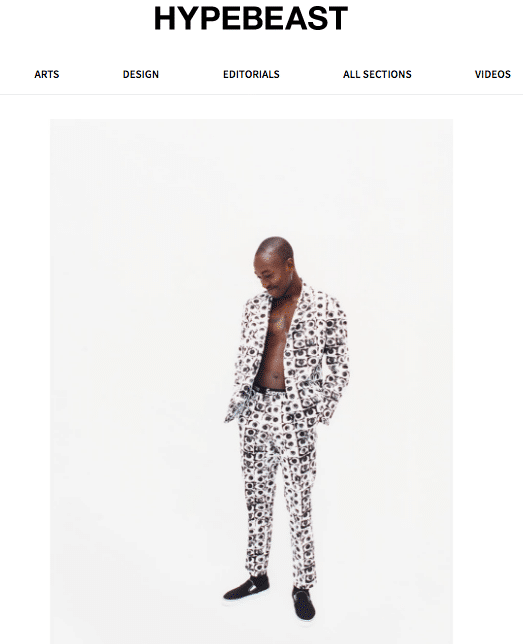
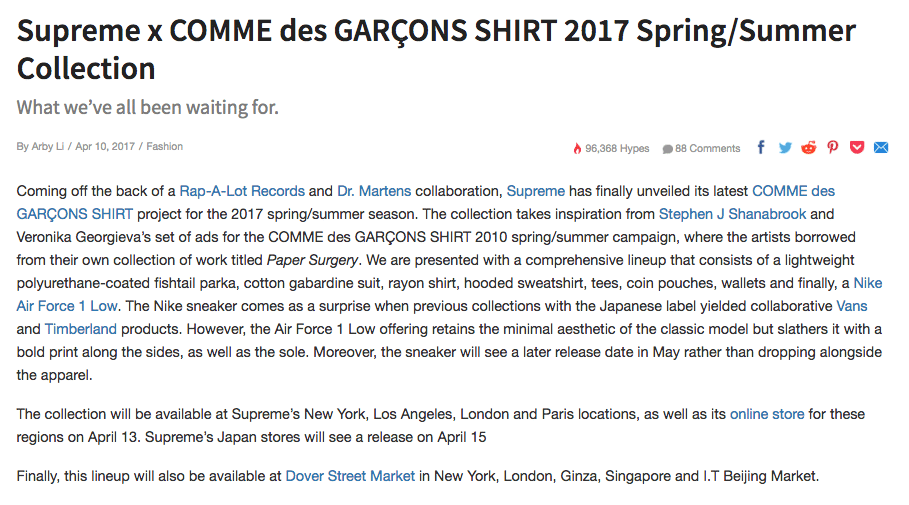
FIVE QUESTIONS WITH… // VERONIKA GEORGIEVA & STEPHEN j SHANABROOK
by Rimma Boshernitsan
Veronika Georgieva and Stephen j Shanabrook join us in our new series ‘Five Questions With…’, a short-form dialogue created to spark curiosity and connection in bite-size form. From colorful childhood memories of the former Soviet Union, to the new concept of “usefull uselessness,” Veronika and Stephen — collaborators and partners in practice — tell us about their backgrounds and inspiration around their work.
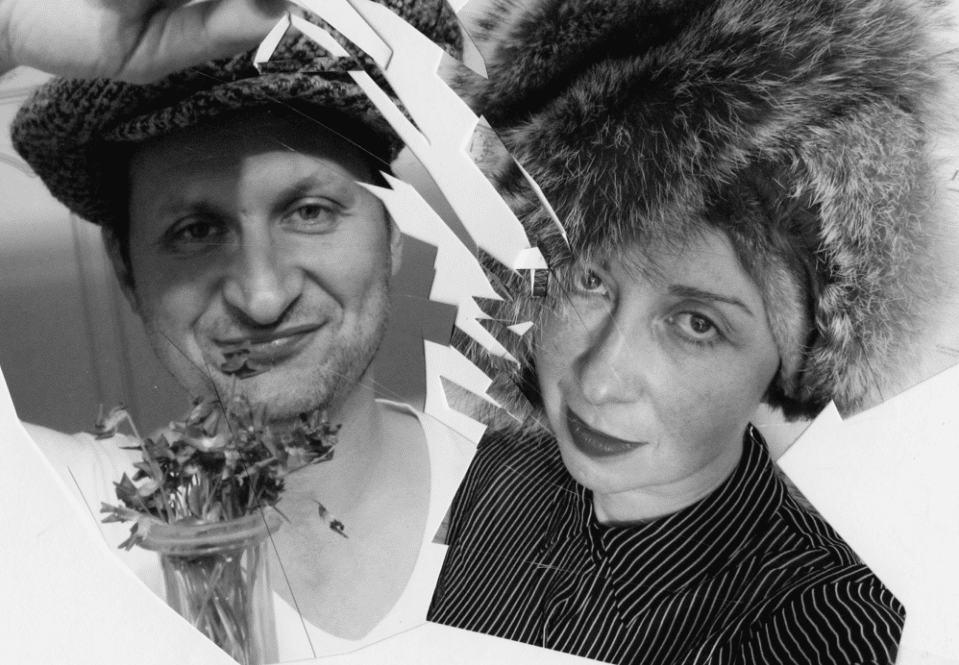
Tell us a little bit about your background(s) and where you grew up?
VG: I was born in and grew up in Moscow, Russia. I had a wonderful “pioneer” childhood, known all-too-well to the children of the former Soviet Union. I sharpened my skills dismantling Kalashnikov weapons in 30 seconds in school and during my later years, graduated from Moscow Architectural University—one of the most liberal colleges in the country.
Meanwhile, Stephen, the son of an obstetrician and the town coroner, spent his childhood working at a chocolate factory and building robots in the basement of his house in rural Ohio. He received a BFA from Syracuse University and studied in Florence, Italy. He has participated in residencies at Skowhegan School of Painting and Sculpture and De Atelier in The Netherlands.
What turns you on creatively, spiritually, and/or emotionally?
SJS: I walk. I like to walk a lot, and from moving and seeing, I get inspired.
VG: I love the sea and forest and hiking, but it never inspires me. My mind is fully at rest when I’m in nature. However, what does inspire me, is any form of communication / connection with people, personally or through their art: books, sculptures, paintings, movies.
What was the impetus for you to start your artistic practice and how did you decide to do it together?
SJS: I wanted to contribute and communicate, but in a way that was “useless”—a sort of useful uselessness. I don’t try to make sense of what I do, organize it, or give meaning to it. It’s like my diary, but in a sculptural way. I call it “emotional conceptualism.” And with Veronika, as life partners, over time, it became apparent that our mutual attraction to the combination of destruction and beauty was something we share on many levels.
Who are you most inspired by (together and individually)?
SJS: The Arte Povera artists’ methods and process in how an endless amount of material can be adapted into an artwork, had a big influence on me.
VG: I am inspired by people who have a strong sense of “being alive.” Those who constantly work on “being alive” like Henry Miller, Bukowski, Tolstoy, Brodsky, and Anna Akhmatova. Not necessarily optimistically alive, but who are sincerely trying to get to the core of themselves, to the core of who they and we are—turning the sufferings into the tool for search. Rilke, Rothko, Proust…
I refuse to be part of modern day’s strong competition in search of success, where artists are demanding to be understood and are willing to kill you with their bigger-than-life description of concepts and explanations. The more it’s unclear to you, the more you are trying to explain your ideas to others. The truth is simple, that’s maybe why we call it artWORK—one’s artwork either works or it doesn’t. By itself. Without you. Get to the core of yourself, work on yourself. The others will follow. Or not. Why does it matter so much anyway?
How would you want to be remembered?
SJS: As I am.
VG: As a piece of cake. A Russian one, not the horrible American sponge one.
BLEND MAGAZINE INTERVIEW
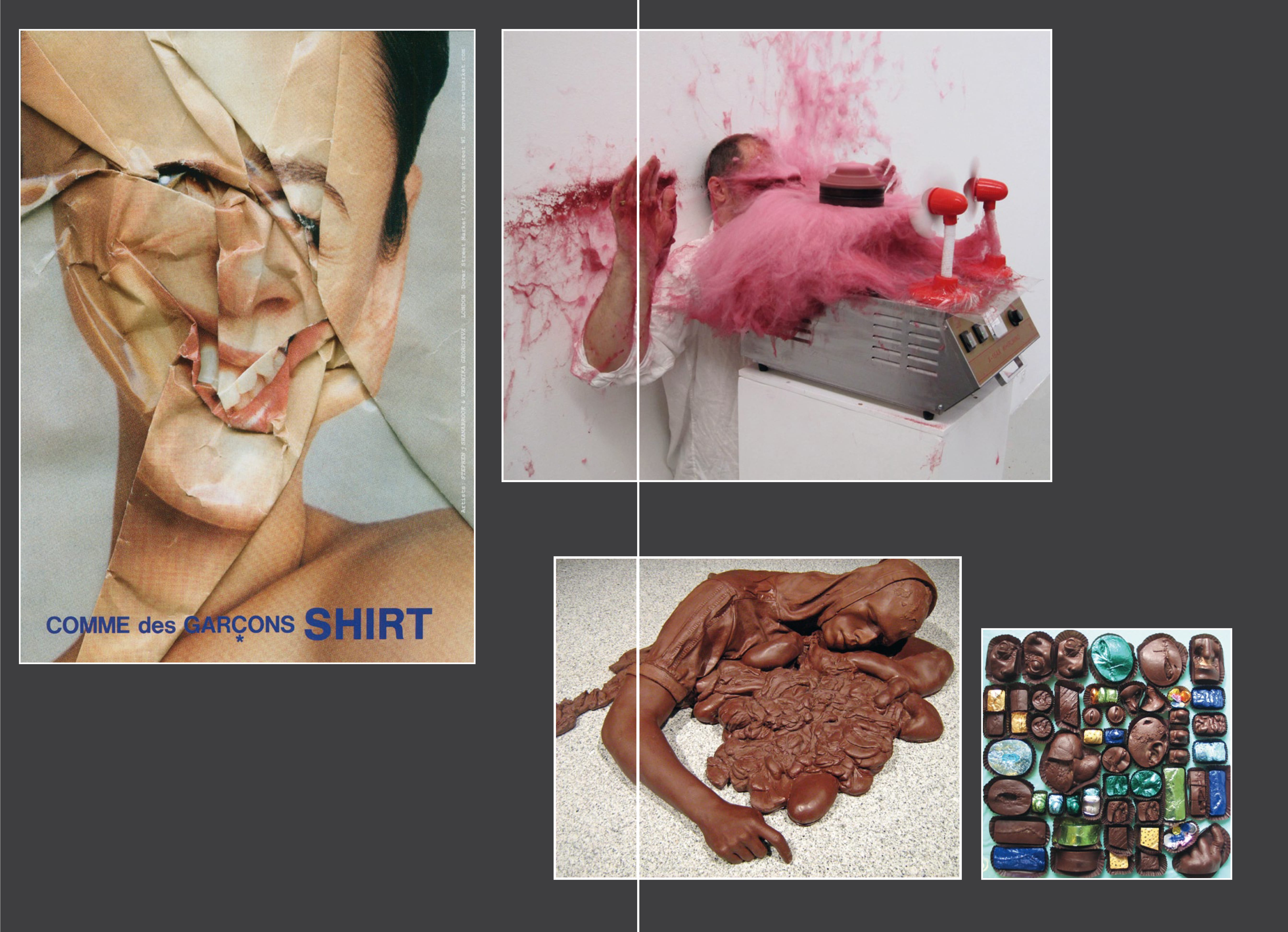
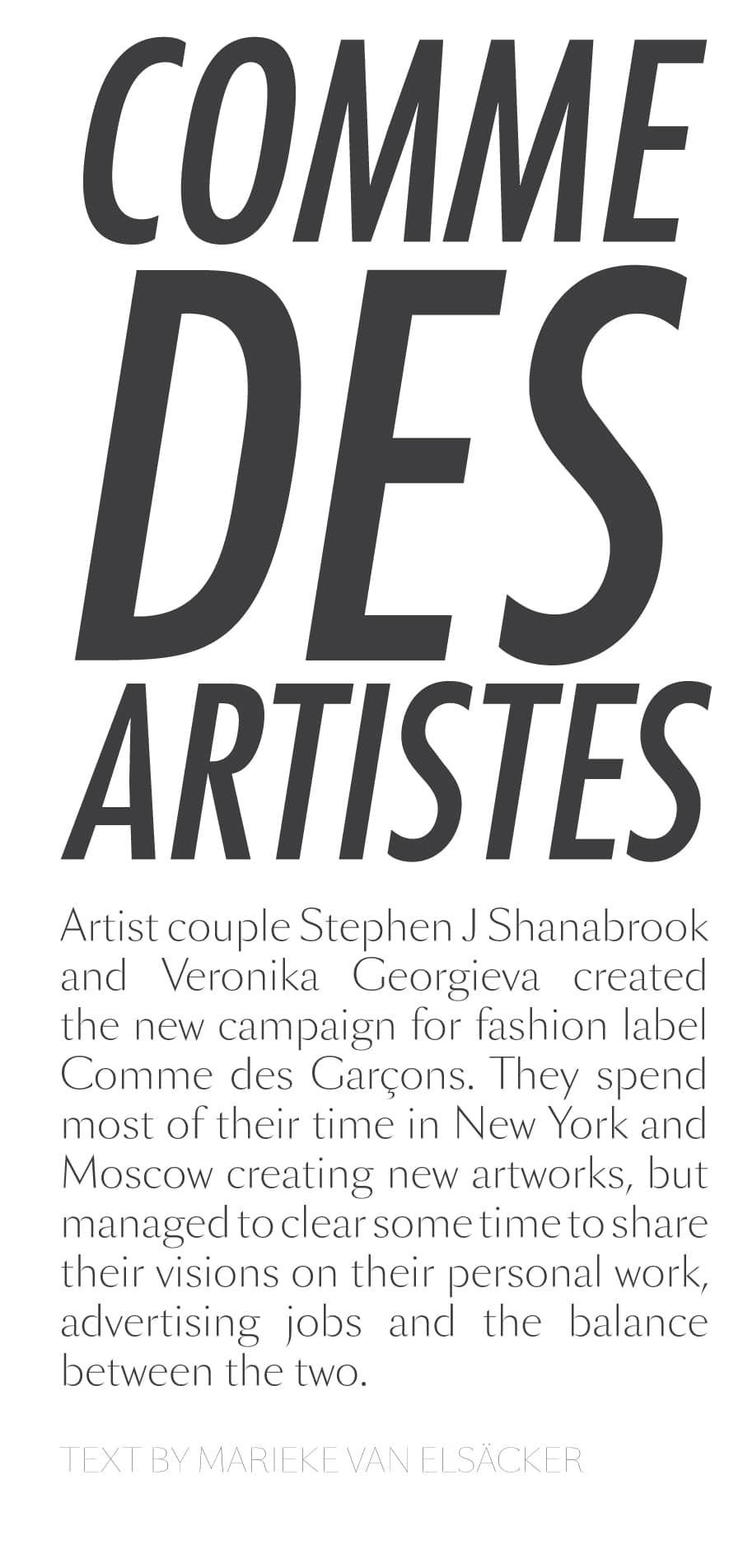
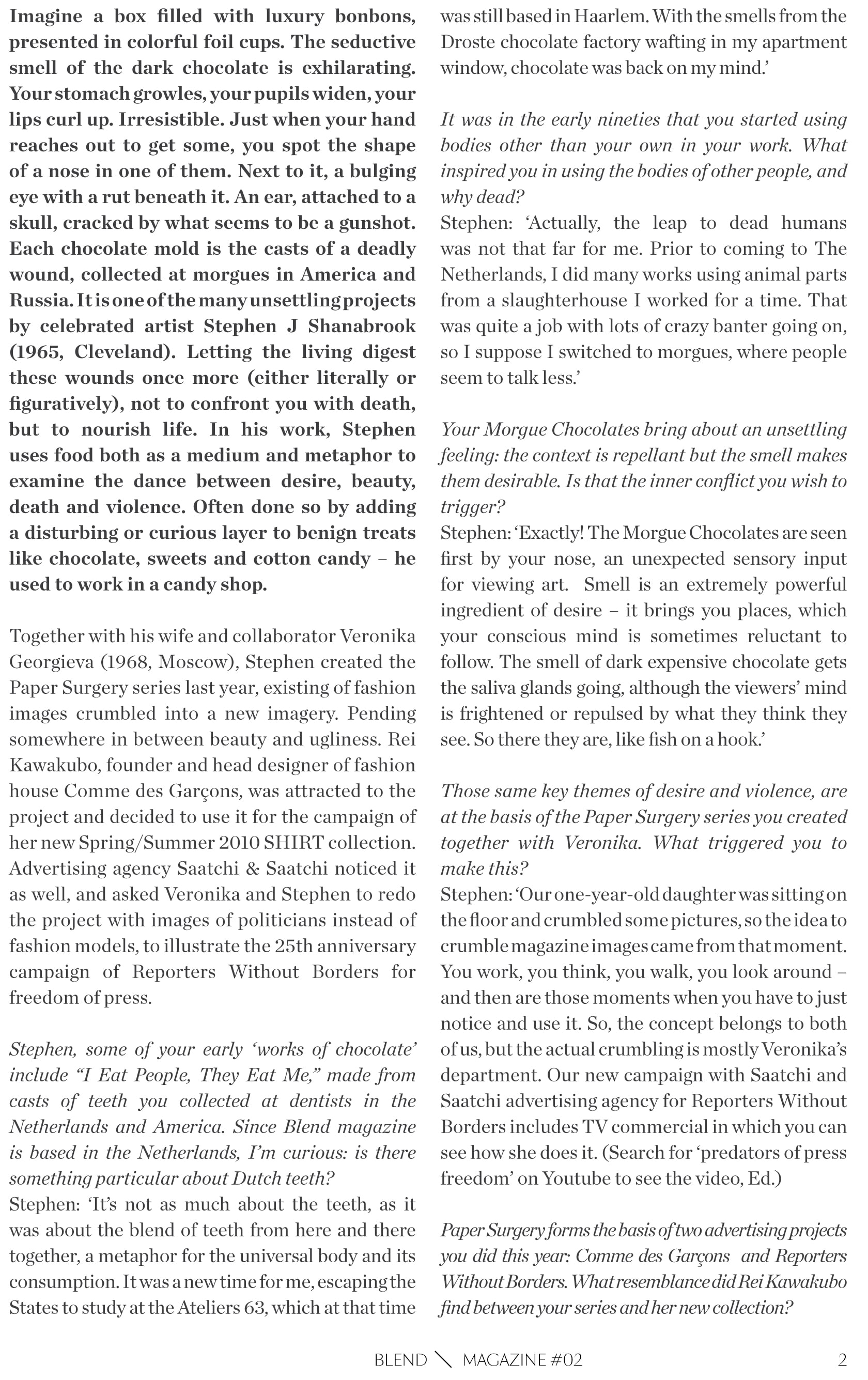
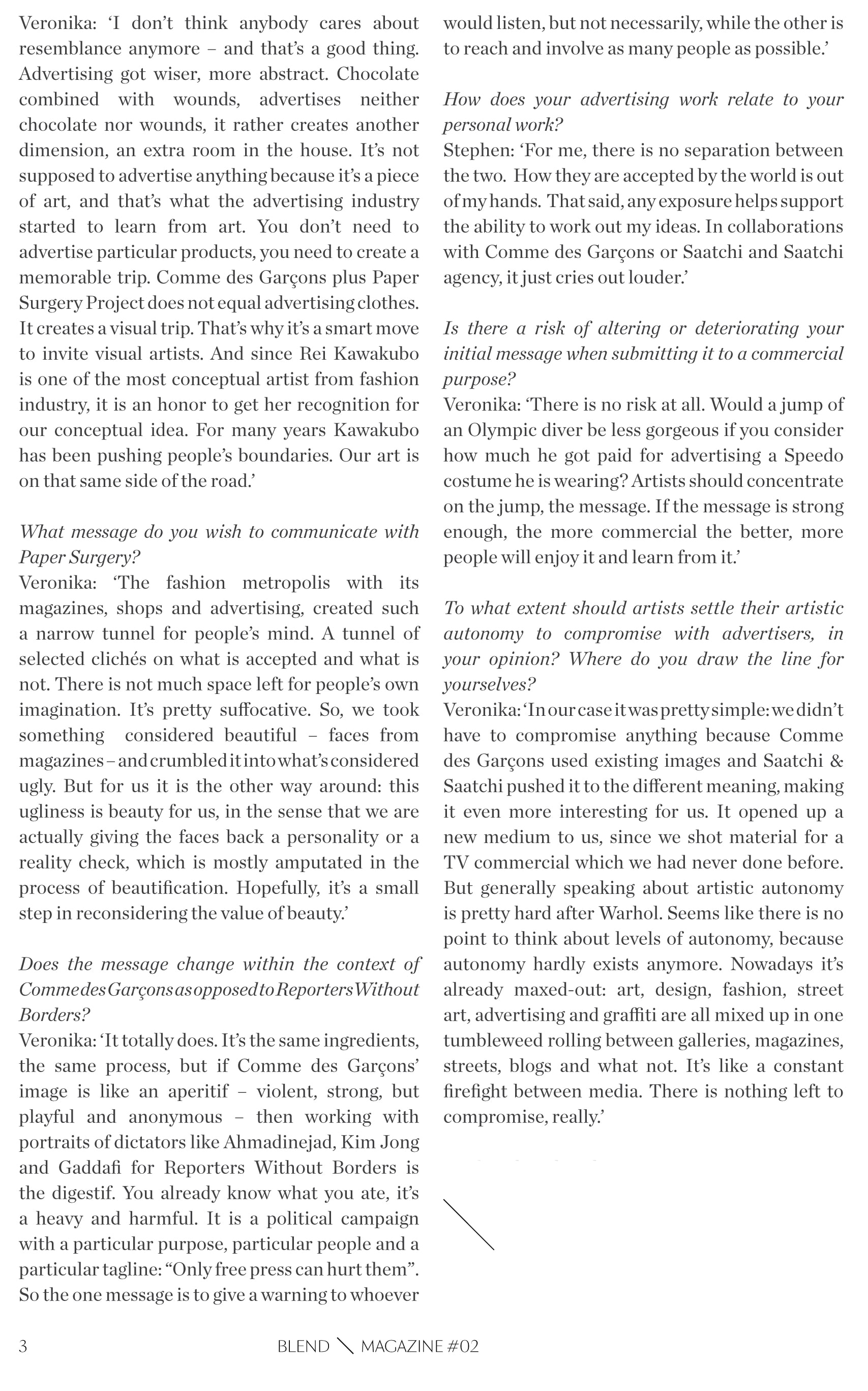

INTERVIEW for Busanilbo Daily News by Hyunchoong Bak
1. Is this Paper Surgery skill? If not, what is the term of skill to crush? Many people surprised that you crush the portrait.
It is not crushing, it’s more like a folding. More like an origami, though result depend on the aim. It called “ Paper Surgery”, and the surgery could safe you or can kill you. Or can make you ugly, as it is reference to the meaning to plastic surgery as well.
2.Why ‘crush way’? What do you want to express?
It’s about consumption of images in our society, perception of “beauty”. Constant digestion of polished magazine beauties like eating the same food over and over – it’s unhealthy, harmful. It becomes place where personality is lost. So, crumbling and folding those images in a kind of violent way, actually gives them personality back. Like distorting, violent gestures in Bacon paintings our crumbling show how vulnerable and tortured and deconstructed our soul and our feelings are. For us Paper Surgery images more human than originals.
3. What do you expect from South Korean suprised by your touch?
The campagne RSF launched in Korea. What’s your message in crushing KIM JungIl. We don’t have a message. We are not involve politically. We’ve been asked by Reporters Without Borders to do this campaign using our particular technic, the technic we invented for our early projects.
4. I want to know you have your own opinion on KIM Jung Il.
We don’t. Except the general one, that dictatorship in general is a bad idea. But rather than that – no, we don’t have our own opinion.
5. Have you ever received any reaction from North Korea? Do you think you are in danger?
No, we didn’t receive any reaction. We can imagine Reporters Without Borders, probably did. But we just a “middle men”, we are hands, not the head of this message.
6. have you ever used the crushing technique on other personalitys? Have you ever received any reaction?(including two other RSF
In “Paper Surgery” project we crumbled magazine images in such a manner that the original images become unrecognizable, painful, violent, and funny at the same time. It is only for RSF we had the purpose for images to stay recognizable in the end. So, as we said , we did other personalities, but one wouldn’t recognize them. And as we said, we didn’t get any reaction to the other two RSF come to us personally.
7. Do you know who used this crushing technique on personality for the first time? It’s you or Veronika ? In general do you know who adopted this technique on arts?
The concept belongs to both of us, but Veronika does the actual crumbling. As much as we know, we used this technic first.
8. Do you have plan to surgery others.
Yes, but not for political reason, only for artistic purposes.
INTERVIEW CENT MAGAZINE
Veronika, Stephen, we are exploring the theme Cornucopia and its various symbols of abundance. The process of ‘fusion’ works with an abundance of references, but it is more than just cutting and putting different things in a metaphorical goat’s horn. As an artist, do you feel fusion is an important aspect of your work, and why?
V: I don’t fully agree that “fusion” grows from big number of references. Often two is enough and sometimes one is enough depending on what you do with it. It could be 1+1=1 and it is a fusion. Fusion is a creative process, not a result. Thats why fusion is not only important but basically crucial for any contemporary artist. We live in times of an information glut, a Cornucopia, which can be a great thing but also a bad one. All depends how you use it – just to produce more crap which doesn’t lead anywhere or use wide diapason of given beginnings in order to combine sometimes most polar things to create new vision. Produce more of the same crap it’s a linear process and doesn’t interest us.
How do you personally play around with this concept of fusing things and putting your stamp on it? Can you tell us more about the surgery aspect that is unique to your work?
S: Since we combine unusual elements and ideas: like wounds and chocolate, pain and pleasure, beatification and distortion etc., I think it makes sense to call it surgery. This particular project is called Paper Surgery because of its’ radical, violent jesters used to distort human faces as well as a reference to plastic surgeries and general acceptance of what is considered as beautiful . We kind of use pain and deconstruction in constructive way, trying to show different aspect of it, the ” beauty” of destructive.
V: The fashion metropolis, with its magazines, shops, advertising, created such a narrow tunnel for people’s mind, tunnel of selected clichés: what is accepted and what is not. There isn’t much space left for people’s own imagination. It’s pretty suffocative. So, we took something considered “beautiful”, faces from magazines, and turn it into what is considered “ugly”. But for us it is the other way around, this “ugliness” – is beauty for us, in that we are actually giving the faces back a “personality” or a reality check, which is mostly amputated in the process of ” beautification”. Hopefully, it’s a small step in reconsidering the value of beauty.
When it comes to fusion in your art work, is less more or is more more?
V: It’s more like a road from destination A which is “more more” to destination B which is “less more”. But wishful result always less is more, the cleaner the better.
Could you please tell us about the spark that inspired ‘Paper Surgery’?
S: Our one-year-old daughter was sitting on the floor and crumbled some pictures, so the idea to crumble magazine images came from that moment. You work, you think, you walk, you look around and then are those moments, when you have to notice as you say “spark” and use it to make a fire. So, the concept belongs to both of us, the actual crumbling is mostly Veronika’s department. Our campaign with Saatchi and Saatchi advertising agency for Reporters Without Borders includes TV commercial. You can see here, how she does it:
Do you think everything fuses together? Do opposites fuse better? Or is it the other way around?